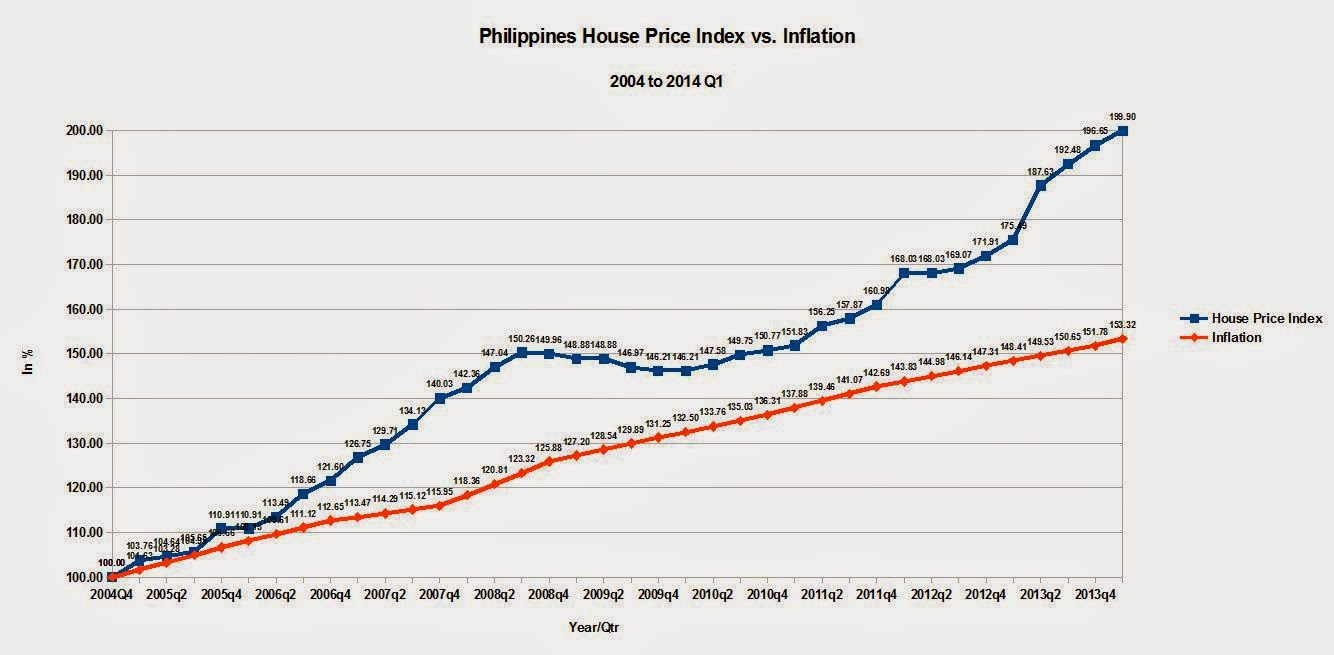Another sign that the Philippines is in the middle of one of the biggest real estate booms in the past twenty years is that employment in the construction industry as a percentage of total employment is at an all time high. As of April 2014, the construction sector now employs 6.8% of all employees, surpassing the peak of the previous boom of 6.2% posted in July 1997, right before the bottom fell out of the market. The current percentage is more than three standard deviations above the sector's long-term historical average of 5.54% (the average from January 1996 to April 2014). The probability of this occurring is low, as in very low - less than 0.3%.
In previous blog posts, we talked about how the Philippine Real Estate Bubble might have already peaked. What we haven't dealt with is the aftermath of that boom, when the boom turns to a bust.
For that, we can turn to the US Construction Industry, which, at its peak, employed 5.0% of all US Workers as of May 2006. This is only slightly above its long term historical average of 4.5% from May 1999 to May 2013. When the US Real Estate Market collapsed, employment in the construction industry collapsed as well. Employment in the sector did not only revert to the mean, it went way beyond it, to compensate for the sector's exuberance during the boom. Today, the sector employs only 3.8% of all US employees. On an absolute basis, the number of jobs in the sector collapsed as well. From a peak of 6.7 million employees as of May 2007, the number of jobs dropped by 1.6 million or 24% to just 5.1 million employees as of May 2013.
Will this happen in the Philippines? We don't know. But if it does, it will be disastrous for the country as a whole.
If employment in the sector merely reverts to the mean, meaning a drop from 6.8% as of April 2014 to its long-term historical average of 5.54%, this will mean 1.26% or 486 thousand people will lose their jobs. If employment in the sector drops to the low end of the range (like 5.0%), this will mean a drop of 1.80% or or a loss 696 thousand jobs.
This just covers the construction sector. It does not take into account how the sector interacts with the rest of the economy. Given that the real estate sector has been one of the major drivers of economic growth, it will not be surprising to see how massive the aftershocks of the real estate bust will be. The US has been through it post 2009 and so has the Philippines after 1997, when the Asian Financial Crisis took hold in the country.
Search This Blog
Wednesday, October 22, 2014
Wednesday, October 8, 2014
The Philippine Consumer Has Not Peaked - Yet
Quite a few previous blog posts have detailed how the Philippine Real Estate Market may have already peaked in terms of sales volume and loans to the residential real estate sector. The Philippine Real Estate Market has yet to peak in terms of price, although some of our ASEAN neighbors have already showed signs of plateauing to declining prices for residential real estate, notably including Singapore and Malaysia.
The two charts below indicate a slowdown in terms of loan growth in the real estate sector.
Since home prices have still continued their relentless climb, this has not yet translated to a sharp uptick in Non-Performing Loans (NPLs) in the sector.
However, there was a slight uptick in NPLs from 3.15% of residential real estate loans in 2013 to 3.34% as of March 2014.
Negative Real Interest Rates
The persistence of negative real interest rates in the Philippines has led, unsurprisingly, to a sharp drop in Gross Domestic Savings Rate as a percentage of GDP since 2010.
Uptick in Consumer Loans
With negative real interest rates, it makes sense for consumers to buy tangible goods, such as real estate and cars, as a store of value. Correspondingly, there was a sharp uptick in total consumer loans both as a percentage of GDP and as a percentage of the Total Loan Portfolio.
The uptick seems to have leveled off since 2012. Most of the increase, it seems, can be attributed to residential real estate loans and auto loans. Again, the leveling off has not yet translated to any notable increase in consumer loan NPLs - yet.
The two charts below indicate a slowdown in terms of loan growth in the real estate sector.
Since home prices have still continued their relentless climb, this has not yet translated to a sharp uptick in Non-Performing Loans (NPLs) in the sector.
However, there was a slight uptick in NPLs from 3.15% of residential real estate loans in 2013 to 3.34% as of March 2014.
Negative Real Interest Rates
The persistence of negative real interest rates in the Philippines has led, unsurprisingly, to a sharp drop in Gross Domestic Savings Rate as a percentage of GDP since 2010.
Uptick in Consumer Loans
With negative real interest rates, it makes sense for consumers to buy tangible goods, such as real estate and cars, as a store of value. Correspondingly, there was a sharp uptick in total consumer loans both as a percentage of GDP and as a percentage of the Total Loan Portfolio.
The uptick seems to have leveled off since 2012. Most of the increase, it seems, can be attributed to residential real estate loans and auto loans. Again, the leveling off has not yet translated to any notable increase in consumer loan NPLs - yet.
Subscribe to:
Posts (Atom)











